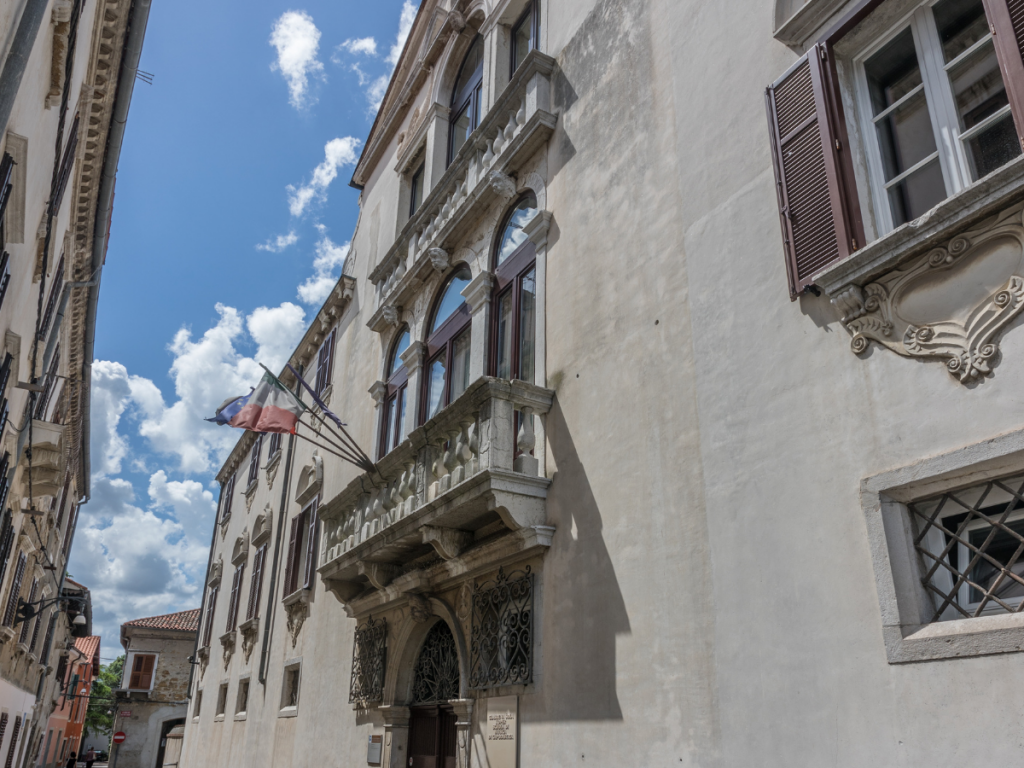
di Luisa Antoni
La cittadina di Capodistria (in sloveno Koper) è situata a una ventina di chilometri di distanza da Trieste. E’ il principale porto della Slovenia ed è, assieme a Pirano, Isola e Ancarano, uno dei quattro comuni che compongono la fascia costiera della Slovenia, in cui l’italiano è riconosciuto come lingua ufficiale.
Capodistria nasce da un antico insediamento costruito su un’isola nella parte sud-orientale della baia omonima e all’epoca dell’antica Grecia era conosciuta con il nome di Aegida, mentre successivamente divenne nota con il nome latino di Capris e nel Medioevo Giustinopoli. Dopo i domini bizantino e romano, fu per cinque secoli veneziana, passando poi sotto l’aquila bicipite.
Al periodo veneziano risalgono i più bei palazzi barocchi dell’Istria con una forte concentrazione a Capodistria. Uno dei più caratteristici è il palazzo dei marchesi Gravisi Barbabianca, in cui si svolge il concerto dei Fiati di Theresia il 7 Maggio 2022.
Ultimato nel 1710, si estende su tre piani ed è uno tra i più importanti monumenti architettonici barocchi capodistriani. La facciata è simmetrica con l’asse centrale enfatizzata dal piano supplementare ed il portale d’ ingresso sovrastato da un balcone riccamente decorato con trifora. Al secondo piano si trova parimenti un balcone con trifora però con decorazioni più modeste e l’asse centrale è accentuata ulteriormente con un timpano che finalizza la decorazione.
Il concerto dei Fiati dell’Orchestra Theresia si tiene alla scuola di musica nella sala principale che è stata affrescata nell’ Ottocento.
Il palazzo è oggi la sede della scuola di musica di Capodistria che è oggi composta da tre scuole di musica del litorale sloveno: Isola, Capodistria e Pirano. La scuola capodistriana è stata fondata su iniziativa del pianista, maestro del coro e didatta Srečko Kumar il 21 dicembre 1948 e ha iniziato ad operare a Portorose in sloveno e italiano. Dopo tre anni è stata trasferita a Capodistria. Nel 1952 fondarono una scuola di musica a Isola e tre anni dopo a Pirano. Inizialmente le due scuole operavano come succursali di Capodistria, ma ben presto divennero indipendenti.
Srečko Kumar si ritirò nel 1952 e il compositore e direttore d’orchestra Vladimir Lovec di cui si festeggiano quest’anno i 100 anni dalla nascita) assunse la direzione della scuola. Su sua iniziativa e su iniziativa di Miran Hasl, nel 1967 tutte e tre le scuole di musica furono fuse in un’unica istituzione, il Centro di Educazione Musicale (CGV). Il suo primo direttore, Miran Hasl, ha gestito e sviluppato con successo CGV per 24 anni.
La qualità del lavoro educativo nell’Istria slovena è testimoniata dai dati sui premi vinti in concorsi nazionali, regionali e internazionali, a cui hanno partecipato numerosi solisti, ensemble da camera e orchestre dal 1971. La bontà del lavoro pedagogico è testimoniata anche degli studenti che superano con successo gli esami di ammissione agli studi universitari in patria e all’estero.
Negli ultimi anni la scuola ha collaborato professionalmente con scuole di musica in Croazia, Repubblica Ceca, Ungheria, Austria, Italia, Paesi Bassi, Germania e Polonia.
The town of Koper is located about twenty kilometers away from Trieste. It is the main port of Slovenia, and together with Piran, Isola and Ankaran, it’s one of the four municipalities that make up the coastal strip of Slovenia, where Italian is recognized as an official language.
Koper was born from an ancient settlement built on an island in the south-eastern part of the bay of the same name and in ancient Greece it was known by the name of Aegida, while later it became known with the Latin name of Capris and in the Middle Ages Giustinopoli. After the Byzantine and Roman dominions, it was Venetian for five centuries, then passing under the double-headed eagle.
The most beautiful Baroque palaces in Istria date back to the Venetian period, with a strong concentration in Koper. One of the most characteristic places is the palace of the Gravisi Barbabianca marquises, where the concert of the Winds of the Theresia Orchestra takes place on May 7, 2022.
Completed in 1710, it extends over three floors and is one of the most important Koper Baroque architectural monuments. The façade is symmetrical with the central axis emphasized by the additional floor and the entrance portal surmounted by a richly decorated balcony with a three-light window. On the second floor there is also a balcony with a three-light window but with more modest decorations and the central axis is further accentuated with a tympanum that finalizes the decoration.
The concert of the Winds of the Theresia Orchestra is held at the music school in the main hall which was frescoed in the nineteenth century.
The palace is now the seat of the Koper music school which is made up of three music schools from the Slovenian coast: Izola, Koper and Piran. The Koper School was founded on the initiative of pianist, choir master and teacher Srečko Kumar on 21 December 1948 and began operating in Portorož in Slovenian and Italian. After three years she was transferred to Koper. In 1952 they founded a music school in Isola and three years later in Piran. The two schools initially operated as Koper branches, but soon became independent.
Srečko Kumar retired in 1952 and composer and conductor Vladimir Lovec, whose 100th birthday is celebrated this year) took over the school. On his initiative together with Miran Hasl, in 1967 all three music schools were merged into a single institution, the Music Education Center (CGV). Its first director, Miran Hasl, has successfully managed and developed CGV for 24 years.
The quality of the educational work in Slovenian Istria is testified by the data on the prizes won in national, regional and international competitions, in which numerous soloists, chamber ensembles and orchestras have participated since 1971. The excellence of the pedagogical work is also testified by the students who successfully pass the entrance exams for university studies at home and abroad.
In the recent years the school has collaborated professionally with music schools in Croatia, the Czech Republic, Hungary, Austria, Italy, the Netherlands, Germany and Poland.


